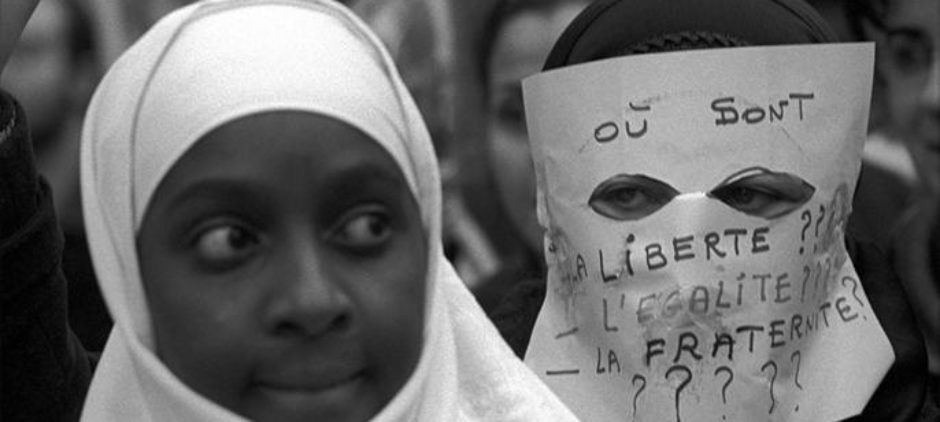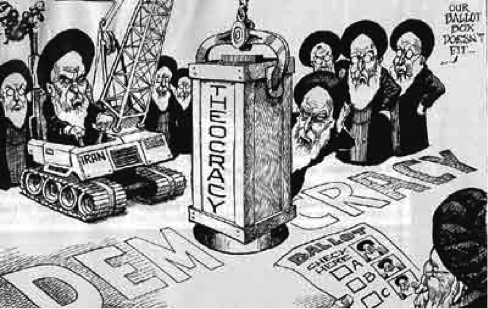The Iranian Revolution cannot be viewed as the starting point for modern Islamic reform in Iran. It should instead be looked at as a stage of reform that exists within a much larger cycle of modernist, secular, and fundamentalist reform movements. I will explore how these movements influence and shape each other within the confines of Iran’s political climate. This idea goes against the belief that these movements exist in absolute contradiction to each other and must have an established path of linear progression in order to achieve “modernity.”
The above cartoon, from the Economist (2004), illustrates the widely held assumption that it is impossible to reconcile theocracy with democracy. It can be argued that while theocracy and democracy often clash with each other, they are not necessarily immiscible concepts. The conflict and convergence of the two ideologies has largely shaped Islamic reform and religious ideology within Iran. This convergence should be seen as less of a paradox and as more of, as Ramin Jahanbegloo suggests, a “duality.” He states, “The duality is… indicated in the very title of the Islamic Republic which refers to an elected republican body with a president and a parliament functioning in the same political structure with the rule of a Faqih” (Jahanbegloo 2010: 27). He goes on to say that these two forces of legitimacy are often what define ideological reforms and political power struggles in Iran (Jahanbegloo 2010: 31). However, many reformists disagree that democracy and theocracy can coexist. Abdolkarim Soroush and Muhammad Shabestari seek to reconcile Islam and democracy through the implementation of secularism. While both advocate for religious secularism, they use different aspects of Islam to promote their notion of religious individualism. Soroush turns to Sufi tradition, while Shabestari reinterprets Islamic jurisprudence in order to delegitimize the Islamic Republic’s religious-political authority (Foody 2015: 602).
Soroush’s argument hinges on his interpretation of some Islamic traditions. As Kathleen Foody shows, “He reimagines significant works from the Islamic tradition to prioritize the religious experience of the individual and to void any external authority over that individual… Soroush denies the utility of the Islamic Republic to govern Muslim practice by positioning Islamic law as secondary and the experience of the individual as primary” (Foody, 2015: 603-604). Soroush focuses on the idea that a Muslim’s personal relationship to his religion takes precedent over any external legal guidance. This is the foundation he uses to promote secular reform. In his article, The Three Cultures, Souroush also aligns himself with Western modernism to some extent. He does not wish to exile Western thought or heritage from Iran. He does not believe the ideals of the West to be incompatible with an authentic Iranian identity (Soroush in Algar 200: 160). This acceptance of the effect of Western influence is certainly something to be considered when studying his secular ideology.
Shabestari, while secularist, takes a different approach than Soroush. Foody states, “Shabestari grounds his own argument in Ghazali’s critique of jurisprudence: ‘Islamic jurisprudence (fiqh) became separated from religious experience and spirituality… this science [of Islamic jurisprudence] became merely worldly (dunyavī)’ (2006c: 421)” (Foody, 2015: 614). Shabestari’s argument is that Islamic jurisprudence in Iran has overstepped its boundaries. It became about limiting an individual’s experience instead of fostering it. In an interesting reinterpretation of the term shari’a, Shabestari illustrates his critique of current Islamic law in Iran. He proposes that, “Islamic jurisprudence has failed to elucidate the true meaning of shariʿa. It is entirely outdated in matters of politics and has forgotten that shariʿa, properly understood, marks the practices that ‘nourish religious experience’ (Shabestari 2006c: 420–421)” (Foody 2015: 613). Foody explains how these reformers were deeply influenced by the political situation from which they wrote, “Whether liberal or authoritarian, modern Muslim understandings of Islam are organized within specifically modern legal systems” (Foody 2015: 617). This is one one the key differences in Iran and the West’s path to modernity. She quotes Friedrich Schleiermacher who states that in the West, “The notion of religious experience provided new grounds upon which to defend religion against secular and scientific critique” (Schleiermacher trans. Sharf in Foody 2015: 617). Foody’s argument is that the political climate in Iran has allowed the idea of religious experience to work against secularism. In Iran, Foody asserts, religious experience has allowed secularist reformers, “To organize an arena of religiosity that is untouchable by state law and the Islamic Republic’s governance of religious action” (Foody 2015: 617).
In contrast to the ideas of Soroush and Shabestari, Ali Shari’ati proposes a very different ideal political Islam. He asserts that, “The essential nature and purpose of religion—[is] not merely to propound a message of salvation in the hereafter but to throw down a challenge to existing secular authority and take hold of the existing social, economic, and political reality of man and transform it into a shape acceptable to God, conforming with man’s purpose” (Algar, 2001: 97). His idea is the opposite of secularism proposed by the other reformers and it often seen as the guiding ideology of the Iranian Revolution. While many argue that this is in opposition to modernity, Ali Mirsepassi sees it as part of modernity, “The ideology of the Iranian Revolution, when viewed in detail, emerges less as a monolithic clash between “modernity” and “tradition,” than as an attempt to actualize a modernity accommodated to national, cultural and historical experiences” (Mirsepassi 2000: 13). Mirsepassi’s argument shows the fallacy in assuming that the West’s path to modernity is a one size fits all approach. It fails to take into account the unique identities that other cultures, nations, and religions have when they start to modernize. Just because the way in which a country progresses does not look like our own history does not mean we should disqualify it from modernity.
Houchang Chehabi emphasizes the important connection that these ideologies of reform have to each other. He states that, “Modernism grew on the basis of the failures of secularism, and fundamentalists owe at least part of their appeal to the failures of the modernists to effect change in Iran. If Iran’s fundamentalist experience does not succeed, the search for an alternative will go on… Modernists may yet have an important role to play” (Chehabi, 1990: 309). This is less of a competition of ideologies, and more of a sway or cycle between seemingly conflicting ideals. The most important point that Chehabi makes is regarding the Revolution and the effect it had on reform movements. He proposes that, “It may be that by mobilizing the masses and by bringing them into the political process in the name of this-worldly interpretation of Islam, the Revolution has actually provided an added impetus for the process of modernization and secularization in Iran” (Chehabi 1990: 309). It is counter intuitive for those people who view modernity as linear and one directional that the rise of a traditional government could actually be the foundation of a more “modern” government. But Iran complicates the notions of linear modernity by blurring the lines between new and old; traditional and modern.
Works Cited:
Algar, Hamid. Roots of the Islamic Revolution in Iran: Four Lectures by Hamid Algar. Oneonta, NY: Islamic Publications International, US, 2001.
Chehabi, H. E. Iranian Politics and Religious Modernism: The Liberation Movement of Iran under the Shah and Khomeini. United States: Cornell University Press, 1990.
Foody, Kathleen. “Interiorizing Islam: Religious Experience and State Oversight in the Islamic Republic of Iran.” Journal of the American Academy of Religion 83, no. 3 (May 7, 2015): 599–623.
Jahanbegloo, Ramin. “The Two Sovereignties and the Legitimacy Crisis in Iran.” Constellations 17, no. 1 (March 2010): 22–30.
Mirsepassi, Ali. Intellectual Discourse and the Politics of Modernization: Negotiating Modernity in Iran (Cambridge Cultural Social Studies). United Kingdom: Cambridge University Press, 2000.
Soroush, Abdolkarim. Reason, Freedom and Democracy in Islam: The Essential Writings of Abdolkarim Soroush. Edited by Mahmoud Sadri and Ahmad Sadri. 1st ed. New York, NY: Oxford University Press, USA, 2000.
“Theocracy.” The Economist [London] 14 Feb. 2004: Print.

